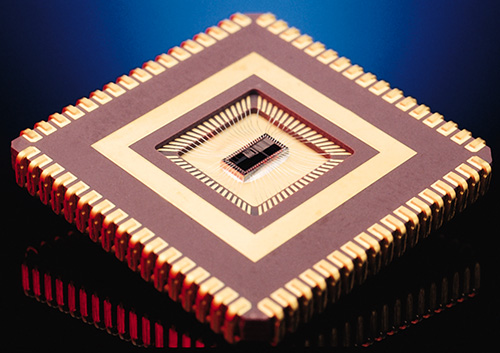Anti-hassle Chip
It is estimated that over 25 million people worldwide have Internet connections. That number is on a fast-moving growth curve daily. However, four out of five people in the United States still remain "Internet no-shows." They remain unconnected due to two primary obstacles: the lack of a personal computer and the perceived complexity of getting on the Internet.
With assistance from Ames Research Center, the iTv Corporation (iTvc), a San Mateo, California-based startup, has introduced a computer chip that minimizes the hassle of logging onto the Internet. The work by iTvc was supported by the Ames Technology Commercialization Center, an organization that "incubates" small businesses. With $900,000 in venture capital funding, raised while in the NASA Ames business incubator, the company was able to proceed with development and rollout of its first innovative product.
Although iTvc is responsible for their own funding, the collaboration with NASA gave iTvc access to the very latest NASA microprocessor technology. NASA contracted with iTvc to adapt a unique microprocessor based on an asynchronous architecture to operations in a space environment. The technology was invented by Charles Moore, one of the three founders of iTvc. Moore was also the inventor of software language used extensively on NASA space probes and satellites.
The company's first product to graduate from the incubator was built to link the Internet to the television, providing a high quality image for electronic mail (email) and World Wide Web browsing. The device uses a proprietary 400 MIPS (millions of instructions per second) throughput microprocessor chip, which was developed during iTvc/NASA collaborative projects.
Instead of using a personal computer, iTvc hardware uses an existing television and telephone line to connect the user to the Internet. With 98 percent of all U.S. households owning a television, the potential market for the equipment is large.
The Internet access hardware provides true plug-and-play. Nothing to configure; no unintelligible computer commands. A connecting of cables, a push of the button, and the connection is made. The system is powered by a breakthrough microprocessor, originally developed for NASA space missions, then adapted by iTvc for fast, powerful yet inexpensive Internet access. A 101-key keyboard is included as standard equipment with the iTvc system.
The company has developed a full custom microprocessor that will enable access to the Internet through an inexpensive device and keyboard. The 100-MHz chip uses a 20-bit wide internal data bus to process 4 instructions per clock cycle. The power of the processor is low, some 90 milliwatts. That is a fraction of the memory and power of conventional microprocessors. Although the primary application of the microprocessor is for Internet access applications, other data path options and coprocessor arrangements can be implemented.
The microprocessor is commercially in quantity production, supported with a compliment of design tools for customization and adaptation as either a licensable core or as a complete microprocessor. In addition to the microprocessor, a full multi-tasking operating system and applications software are available for complete Internet access-World Wide Web browsing and electronic mail.
Other uses of the microprocessor include cell phones, DVD players, cable modems, video conferencing equipment, digital cameras, and wireless local area networks and wide area networks. In general terms, the iTvc microprocessor supports at least a $100 reduction in costs of mass market consumer electronics, relates Gary Langford, President of iTvc. That means big business, he says.
"A forecast for the Internet is its use by almost every household in the United States within 15 years, with half of all homes having the Internet in 6 years," Langford says. The reality of this forecast will only happen if the Internet devices are inexpensive and easy to operate, he adds.
In 1997, iTvc raised several million dollars in venture capital. First trial demonstrations of the company's Internet appliance started in full swing. The company is currently working in partnership with Korean and Japanese electronic manufacturers to design new, low-cost consumer products. NASA has expressed interest in iTvc's computer prowess for a set of Earth observing satellites and the search for life on Mars, to handle massive streams of data broadcast from these spacecraft missions.

Smarts on a chip. This multiprocessor is the brain behind iTvc's low-cost approach to making the Internet available through the television. The micro-processor is adapted from electronics technology designed for robotic Mars missions.













